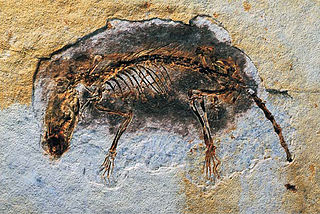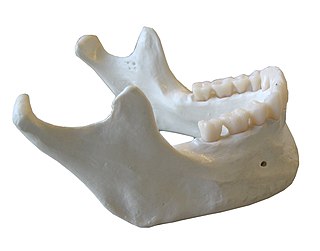
Eomaia is a genus of extinct fossil mammals containing the single species Eomaia scansoria, discovered in rocks that were found in the Yixian Formation, Liaoning Province, China, and dated to the Barremian Age of the Lower Cretaceous about 125 million years ago. The single fossil specimen of this species is 10 centimetres (3.9 in) in length and virtually complete. An estimate of the body weight is between 20–25 grams (0.71–0.88 oz). It is exceptionally well-preserved for a 125-million-year-old specimen. Although the fossil's skull is squashed flat, its teeth, tiny foot bones, cartilages and even its fur are visible.
Condylarthra is an informal group – previously considered an order – of extinct placental mammals, known primarily from the Paleocene and Eocene epochs. They are considered early, primitive ungulates. It is now largely considered to be a wastebasket taxon, having served as a dumping ground for classifying ungulates which had not been clearly established as part of either Perissodactyla or Cetartiodactyla, being composed thus of several unrelated lineages.

Entelodontidae, the entelodonts, are an extinct family of pig-like artiodactyls which inhabited the Northern Hemisphere from the late Eocene to the Middle Miocene epochs, about 38-19 million years ago. Their large heads, low snouts, narrow gait, and proposed omnivorous diet inspires comparisons to suids and tayassuids (peccaries), and historically they have been considered closely related to these families purely on a morphological basis. However, studies which combine morphological and molecular (genetic) data on artiodactyls instead suggest that entelodonts are cetancodontamorphs, more closely related to hippos and cetaceans than to pigs or other ungulates.

Laganosuchus is an extinct genus of stomatosuchid crocodyliform. Fossils have been found from Niger and Morocco and date back to the Upper Cretaceous.

Platyognathus is an extinct genus of protosuchian crocodylomorph. Fossils are known from the Early Jurassic Lower Lufeng Formation in Yunnan, China and belong to the type and only species, P. hsui.

Eritherium is an extinct genus of early Proboscidea found in the Ouled Abdoun basin, Morocco. It lived about 60 million years ago. It was first named by Emmanuel Gheerbrant in 2009 and the type species is Eritherium azzouzorum. Eritherium is the oldest, smallest and most primitive known elephant relative.

In anatomy, the mandible, lower jaw or jawbone is the largest, strongest and lowest bone in the human facial skeleton. It forms the lower jaw and holds the lower teeth in place. The mandible sits beneath the maxilla. It is the only movable bone of the skull. It is connected to the temporal bones by the temporomandibular joints.
Deccanolestes is a scansorial, basal Euarchontan from the Late Cretaceous (Maastrichtian) and Paleocene Intertrappean Beds of Andhra Pradesh, India. It may be closely related to Sahnitherium. Deccanolestes has been referred to Palaeoryctidae in the past, but recent evidence has shown that it is either the most basal Euarchontan, as the earliest known Adapisoriculid, or as a stem-afrotherian.

Nankangia is an extinct genus of caenagnathoid oviraptorosaurian dinosaur known from the Upper Cretaceous Nanxiong Formation of Nankang County, Ganzhou City of Jiangxi Province, southeastern China. It contains a single species, Nankangia jiangxiensis. N. jiangxiensis coexisted with at least four other caenagnathoids, including an unnamed oviraptorid, Banji long, Ganzhousaurus nankangensis and Jiangxisaurus ganzhouensis. The relatively short dentary and non-downturned mandibular symphysis of Nankangia suggest that it may have been more herbivorous than carnivorous. Its diet consisted of leaves and seeds.

Ocepeia is an extinct genus of afrotherian mammal that lived in present-day Morocco during the middle Paleocene epoch, approximately 60 million years ago. First named and described in 2001, the type species is O. daouiensis from the Selandian stage of Morocco's Ouled Abdoun Basin. A second, larger species, O. grandis, is known from the Thanetian, a slightly younger stage in the same area. In life, the two species are estimated to have weighed about 3.5 kg (7.7 lb) and 10 kg (22 lb), respectively, and are believed to have been specialized leaf-eaters. The fossil skulls of Ocepeia are the oldest known afrotherian skulls, and the best-known of any Paleocene mammal in Africa.
Oxlestes is an extinct mammal from the Late Cretaceous of Asia, more specifically from the Cenomanian of Uzbekistan. A carnivorous species of uncertain affinities, it is notable for its relatively large size, being among the largest of all Mesozoic mammals. Due to the limited amount of material, it has been considered a nomen dubium.

Aymberedactylus is a genus of tapejarid pterosaur from the Early Cretaceous Crato Formation of Brazil. It contains a single species, A. cearensis.

Tsagandelta is a genus of deltatheroidean therian mammal that lived in Asia during the Late Cretaceous. Distantly related to modern marsupials, it is part of Deltatheroida, a lineage of carnivorous metatherians common in the Cretaceous of Asia and among the most successful non-theropod carnivores of the region. It represents the first known mammal from the Bayan Shireh Formation.
Zhelestidae is a lineage of extinct eutherian mammals. Occurring in the Late Cretaceous from the Turonian to the Maastrichtian, they were an extremely successful group, with representatives present in Europe, Asia, India, Africa and North America, ostensibly rendering them a cosmopolitan clade. They were specialised towards an herbivorous lifestyle and were in fact initially considered stem-ungulates, but the presence of epipubics and "archaic" dental characters render them as non-placental eutherians.

Zalambdalestidae is a clade of Asian eutherians occurring during the Late Cretaceous. Once classified as Glires, features like epipubic bones and various cranial elements have identified these animals as outside of Placentalia, representing thus a specialised clade of non-placental eutherians without any living descendants, and potentially rather different from modern placentals in at least reproductive anatomy.
Valentinella is a Late Cretaceous genus of eutherian mammal from France, Europe. It was originally known from some damaged lower and upper jaws, and was cautiously referred to the lainodontine zhelestid mammals. This identification was later questioned and even considered a nomen dubium by some researchers, and remains uncertain due to the scarcity and fragmentary nature of the fossils.
Azygonyx was a small tillodont mammal, likely the size of a cat to raccoon, that lived in North America during the Paleocene and Eocene in the early part of the Cenozoic Era. The only fossils that have been recovered are from the Willwood and Fort Union Formations in the Bighorn Basin of Wyoming, United States, and date to the Clarkforkian to Wasatchian, about 56 to 50 million years ago. Fifty-six collections that have been recovered thus far include the remains of Azygonyx. Azygonyx survived the Paleocene Eocene Thermal Maximum along with other mammals like Phenacodus and Ectocion, both of which were ground-dwelling mammals. Azygonyx probably was a generalist terrestrial mammal that may have roamed around the ground, but was also capable of climbing trees.

Antaeusuchus taouzensis is a species of peirosaurid notosuchian from the Late Cretaceous Kem Kem Group of Morocco. It was described in 2021, and it is the only species in the genus Antaeusuchus. It is the fourth notosuchian described from the region and the second Kem Kem peirosaurid after Hamadasuchus.
Barrosasuchus is a genus of peirosaurid notosuchian from the Santonian of Argentina and part of the extensive peirosaurid record of Late Cretaceous Patagonia. It contains one species, Barrosasuchus neuquenianus. B. neuquenianus is known from an almost complete skull and the majority of the articulated postcranial skeleton, making it the best preserved Patagonian peirosaurid.

Kyhytysuka is an extinct genus of ophthalmosaurian ichthyosaur from Early Cretaceous Colombia. The animal was previously assigned to the genus Platypterygius, but given its own genus in 2021. Kyhytysuka was a mid-sized ophthalmosaurian with heterodont dentition and several adaptations suggesting that it was a macropredatory vertebrate hunter living in shallow waters. It contains a single species, Kyhytysuka sachicarum.

















